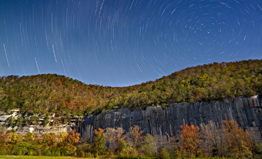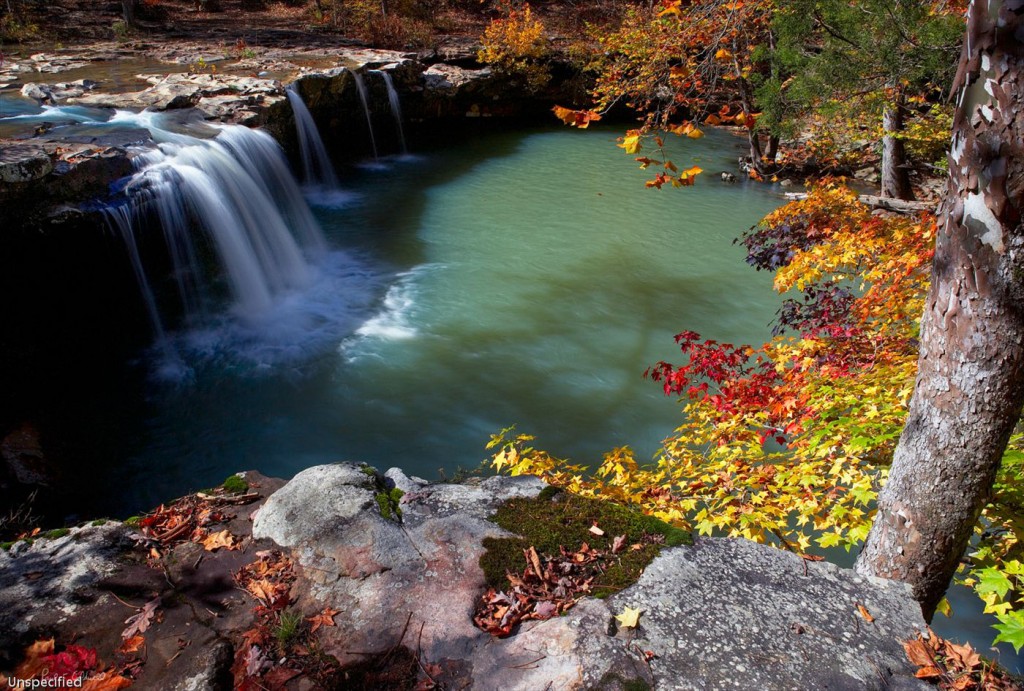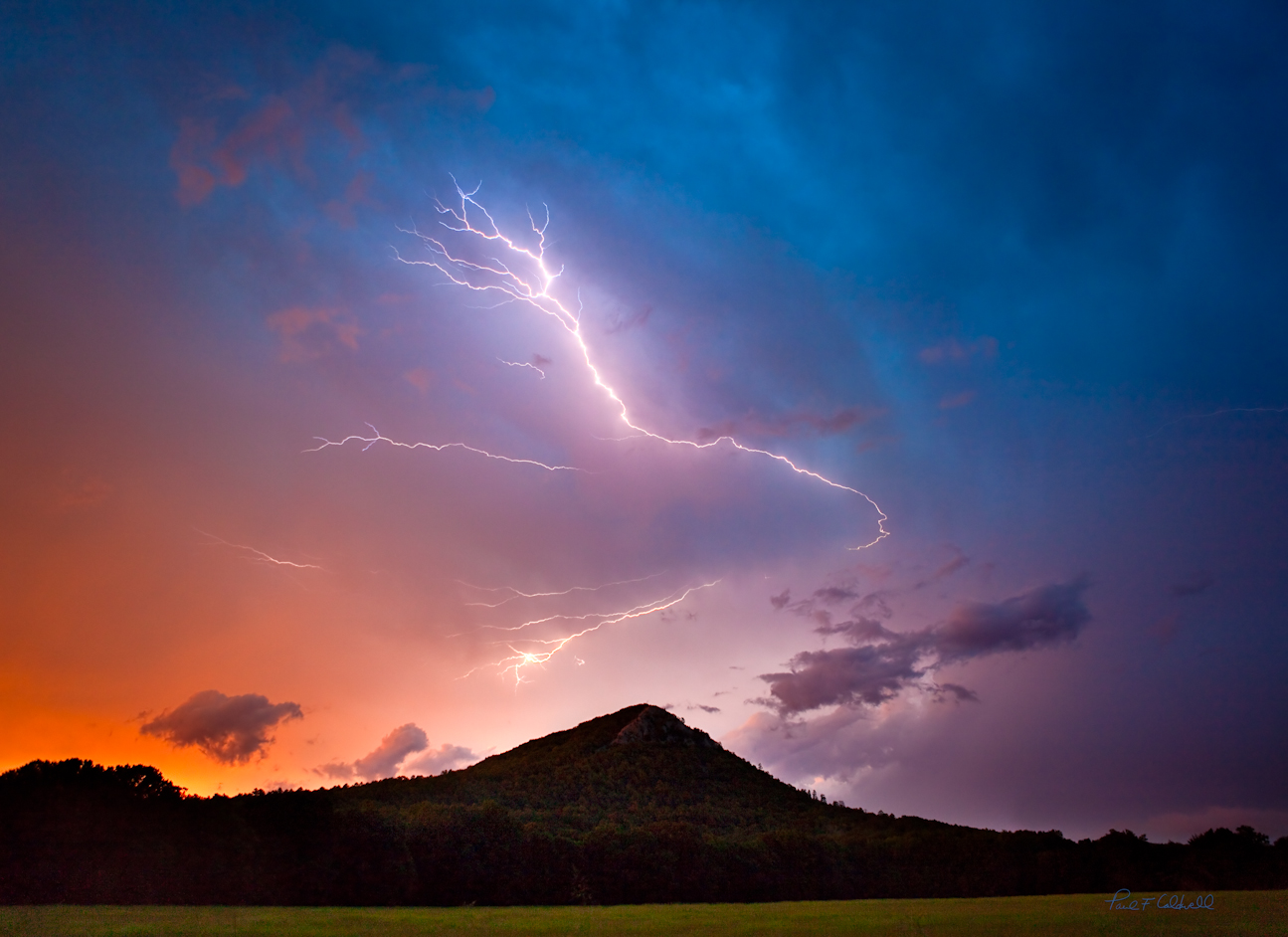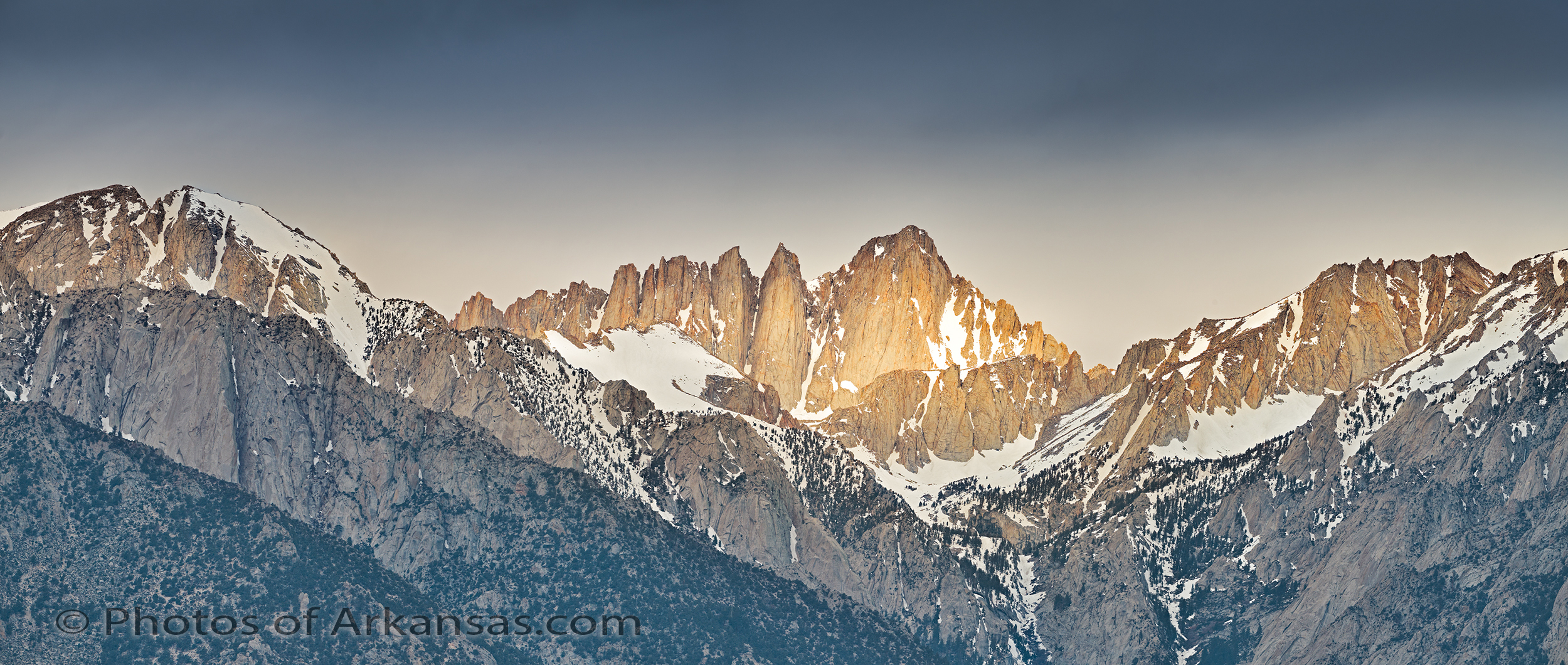02/23/13 Featured Arkansas Photography–Night skies over Area 51 in Western Pulaski County Arkansas
Taken with a Canon 5D MKII with a 16-35mm lens @ F4.5 for approximately 4o minutes. Area 51, in Little Rock, not out in the desert. Yes, Arkansas has it’s are 51! It’s a great spot to view Pinnacle mountain as there is big field in front of the mountain and the area 51 sign just adds to the effect of the shot. This is a harder spot to work than one might think as the constant stream of cars coming by. The headlights can really blow out a stacked exposure and to get this shot I had to work in the foreground from several different image since the lights were totally blowing out the image. I liked the way the sky came out, with a amber color towards the horizon and then a nice fade into a deep blue. I was barely able to catch the north star in the upper left corner. I was working against a very bright moon but I was able to finally get into a spot where I could use the large tree on the right to block most of the moonlight. I love this spot and go out to it many time during the year.
02/21/2013 Featured Arkansas Photography–Night skies over Twin Rivers Park
Taken with a Nikon D800e, 14-24 lens@ 17mm, F4.5, iso 400. Image is the result of a series of 35 second frames that were stacked together. Well, it’s been a while since I put up anything new, and I do have my reasons, but I am going to try and get a bit more current. This shot was taken over the new bridge at Twin Rivers Park, in Little Rock. This is a new subject for me but one I have wanted to explore for a while now. The bridge has a series of bright lights that run along it’s course so it added an additional challenge for any type of shooting. If you exposed the bridge for 35 seconds, it would be totally over exposed, but I need the 35 seconds for the stars. So the solution is to expose a series for the bridge after the stack is done, then combine the images together later. The bridge added one other problem in that it had a much brighter center that would go off like a search light every once and while. You can still the effect in the center of the image, but I felt it was balanced enough as I had it. The effect of the center light is a bit harsher in the smaller jpg file I have uploaded for the web. I was blessed to be shooting with Dr. Smith that night and only to have a few planes overhead.
12/04/12 Featured Arkansas Photography–Fall Scene along Falling Water Creek
Taken with a Canon 1DS MKII, Canon 24-70 Lens @ 24mm, F11, iso 100. If you have the time, one of the best short hikes in Arkansas is along Falling Water Creek. You can find plenty of small waterfalls along the way. The best place to start is from the Falling Water Falls waterfall on Forest Service road 1205. Hike downstream for about the next 2 miles and you will be very pleasantly surprise. If you run into any trouble, just hike up the hillside on the left side of the creek (facing downstream) and you will eventually come back to FR 1205. I would plan for this hike when Falling Water Creek is not running so high that a crossing would be unsafe. You can easily judge the height of the creek by viewing the water comin over Falling Water Falls. In this 2 mile stretch of the creek you should find several great waterfalls entering the creek.
11/20/12 Featured Arkansas Photography–Prayer meeting at the narrows, Buffalo National River
Taken with a Canon 5D MKII, Canon 14mm lens @ F11 for 1/60 of a second, iso 200. I love to work the narrows on the Buffalo River. It’s a very unique spot in Arkansas. Here you have a long bluff that had at one time been eroded by two different streams. One, the Buffalo which can be seen in the picture and the 2nd, Richland Creek. Richland long ago moved it banks away from this bluff, but is still close by and empties into the Buffalo not far downstream from where this picture was taken. On this day I was waiting and hoping that all the cloud cover would break off and give me some blue sky. It was late fall in 2010 but I still had some great color along the banks of the Buffalo. While I was waiting, a group of Mennonite women came down the bluff from behind me. I was surprised by this, as I only thought that there was one way up, but they had a different location to gain access. They climbed down the steeper end of the bluff which is behind from where this shot was taken, then walked along the narrows and climbed the smaller bluff in the distance. There they held a prayer meeting. You can see them barely in the distance on the right side of the bluff in the distance near the river. IF YOU CAN’T SEE THEM CLICK ON THE IMAGE FOR A LARGER VIEW.
10/28/12 Featured Arkansas Photography–Early morning light at Gunner Pool Campground
Taken with a Canon 1ds MKII, lens Canon 24-70 at 24mm, iso 400, 1/60 of a second, handheld.
When working early in the morning I love to hike along Arkansas Forest Service roads as they can offer some great candid shots. This photograph was taken near the Gunner Pool campground which is near Sylamore Creek. When this shot was taken, I had gotten up early to work along Sylamore creek and was heading back to my car, when I looked back and caught this ray of sunlight striking the road. The fall colors were about at their peak and there was no wind blowing. There was a bit of smoke coming from old camp fires and it just added to the overall look and effect of the scene.
10/09/12 Featured Arkansas Photography–Stars over Roark Bluff late October
Taken with a Phase One P45+, 45 minutes, 35mm F3.5 lens @ F4.5, iso 50, Phase One DF Camera, One of the most amazing aspects of photography is working with time lapse shooting at night. By leaving the camera shutter open and using just the ambient lighting from the moon, you can get some great night photographs. In this shot I was working the Buffalo River Valley near Steel Creek which is one of the most popular spots along the upper Buffalo. There were no clouds and the sky was very clear with very little wind, perfect conditions for night work. I left the shutter open for 45 minutes which allowed me to capture the movement of the earth around the north star. If you can find the north star in the night sky then you will get the concentric circles outward from the north star. If you don’t have the north star, then you will get different patterns to the star movement, sometimes waves or other partial circles. I feel that the best shot will have a northern view even if the north star has dropped below the horizon. Remember, the moonlight will give the sky the wonderful blue tint.
10/06/12 Featured Arkansas Photography–Wintertime sunset at Flatside Pinnacle
Taken in January 2012, Camera Digital-Phase One IQ160 mounted to Arca rm3di, Lens-Rodenstock 28mm HR, 2 exposures to create a exposure bracket. The wintertime in Arkansas can be very photogenic. I was out on Flatside in early January 2012 working with a new Rodenstock 28mm HR lens with a Arca Swiss rm3di. I wanted to test the lens in various combinations of focus and tilt. For this shot I was able to get a hyperfocal of about 24 inches to infinity. I used approximately 1/2 of a degree of downward tilt on the Arca rm3di. The corresponding depth of field was amazing. For this shot I took off my polarizer as it just did seem to make much difference. The Phase One IQ160 performed very well here. In the past when working with my older Phase One P45+, I found shots like this one impossible since the P45+ was impossible to work with bright highlights. For example on this shot I would have needed to take a shot for just the sun and these several more exposure brackets to try and pull in the shadows in the foreground. The Phase One IQ160 did this shot in 2 exposures. I still couldn’t get it all in one, but I found the Dynamic Range of the Phase One IQ160 a vast improvement over my P45+.
10/02/12 Featured Arkansas Photography–Branch in the Fog on Roark Bluff
Taken with a Canon 5D MKII, Canon 24-70 lens, F 7.1 at 1/40th, iso 400. When I am out working in the early morning, I often try to find shots where the fog can act as a major effect in the shot. On a morning like this, the fog did not lift for almost 3 hours but as it started, the sun briefly highlighted this lone branch which was just starting to leaf out in spring. Many people have looked at this shot and felt that it was taken in the fall, however if you look closely you can see that the oak leaves are just starting to open. This lone tree has taken a beating over the years but each time I come back to this spot it still there and and survived for another season of snow and ice during a typical Ozark winter. During the time I took this shot you could hear trucks and cars moving around in the valley below and people’s voices, but as the fog was so thick you couldn’t see anything. This is a great time to work the Ozark Bluffs and not just on the Buffalo River, but the Buffalo tends to allow for more fog.
09/17/12 Featured Arkansas Photography–Fall morning on Richland Creek in Newton County Arkansas
Taken with a Canon 1ds MKII, Mamiya 35mm Lens with a Zork Adapter, F16, for approximately 1/60th of a second, iso 100. I love Richland creek and have hiked it more times than any other location in Arkansas. The scenery on Richland has to be some of the best in Arkansas. In the fall, mostly you get a low water condition like this photograph shows where the water is only holding in the pools. This offers great reflection shooting and many times the leaves will build up like they did in this photo. You have to catch Richland at just the right time as the leaves only stay in good color for about 3 days. I try to make it up there at least once during the fall. You can also catch some great color further down the creek near the campground as two of the largest pools on Richland are here. If you are very lucky, Richland will be running and the hike up the creek is one to remember. All the various rapids have excellent photographic opportunities. Make sure you allow for the entire day so that you can take it all in.
09/11/12 Featured Arkansas Photography–Falling Water Falls in Searcy County
Taken with a Canon 1ds MKII, Canon 24-70 lens @24mm, F14 for approximately .5 seconds, iso 100. Falling water falls is one of the easier spots to get to in Arkansas. You can drive right up to it! Unfortunately this works against photography since you almost never find these falls without someone standing at the rim. I have never really understood the need to walk out and just stand there, but I guess there is some necessary fulfillment that some folks need. On the weekends, you can always expect to find a crowd here so if you are thinking about a trip, try to plan it on the weekdays and try to get there early.
Read More»
































